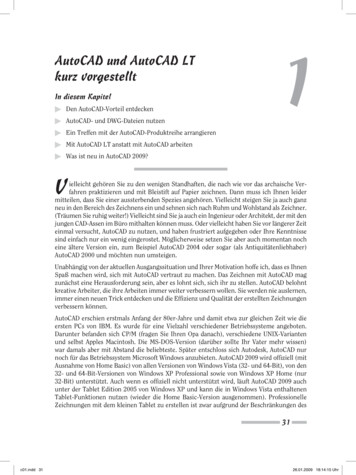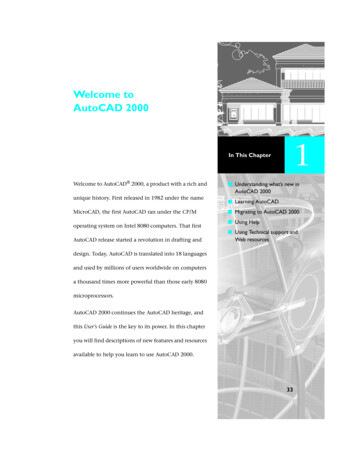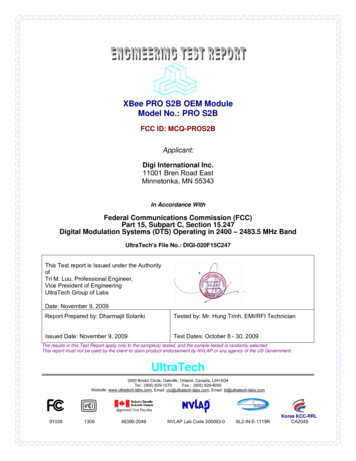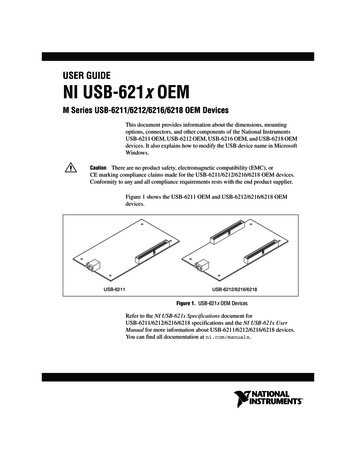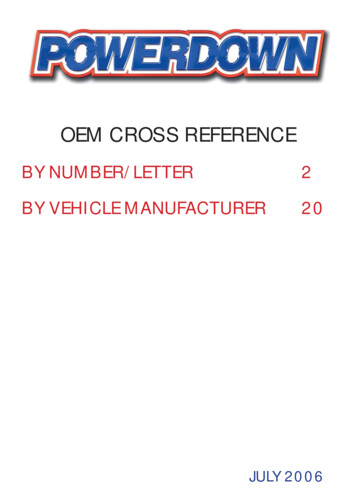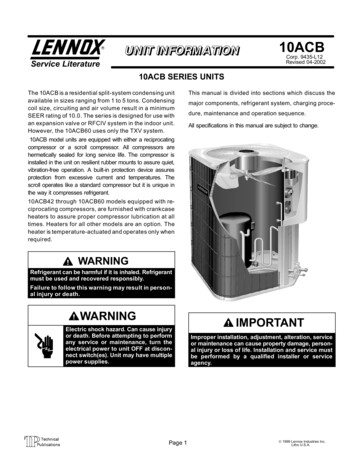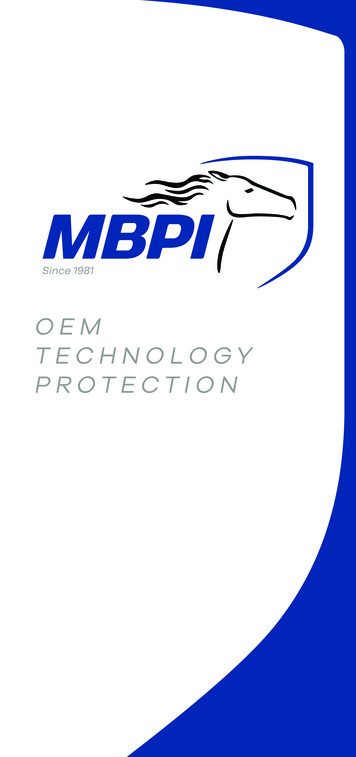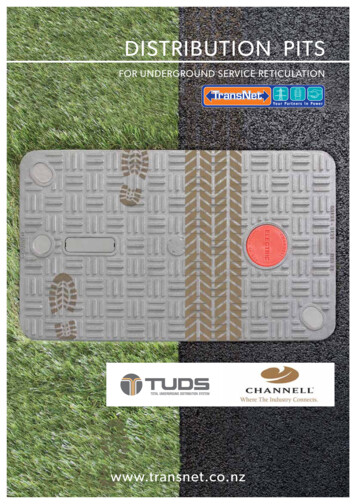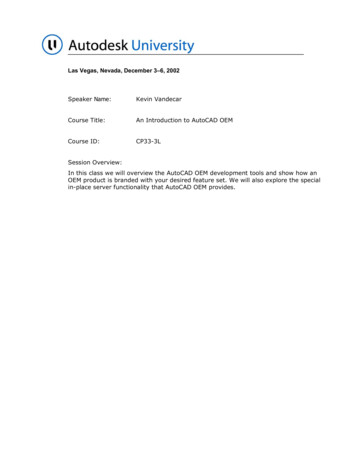
Transcription
Las Vegas, Nevada, December 3–6, 2002Speaker Name:Kevin VandecarCourse Title:An Introduction to AutoCAD OEMCourse ID:CP33-3LSession Overview:In this class we will overview the AutoCAD OEM development tools and show how anOEM product is branded with your desired feature set. We will also explore the specialin-place server functionality that AutoCAD OEM provides.
Autodesk University 2002CP33-3LAn Introduction to AutoCAD OEMIntroductionNote: Parts of this tutorial is taken directly from the AutoCAD OEMDeveloper’s Guide.In this tutorial, you will create a fully customized, AutoCAD OEM-based product calledPolyCAD. You will use the AutoCAD OEM Make wizard, build modules, and then editsupport files. The product name, PolyCAD, will be reflected in the names of twodirectories that the wizard will create during the tutorial.To create your AutoCAD OEM-based product, you will use the AutoCAD OEM Makewizard to stamp your product and build default resources. Using your product's name,the wizard will create: A projects\poly directory, which contains a toolkit subdirectory with all theresources to be customized for the product An oem\polycad subdirectory with a run tree containing the framework for yourapplicationLab01 -- Application FrameworkTo build your application framework1. Start the AutoCAD OEM Make wizard from the Start menu or the desktop icon.The wizard starts with the correct AutoCAD OEM location initialized. (If you start thewizard from the toolkit directory, you must enter the location of the aoem.exe file.)2. On the Introduction page, choose Next.www.autodesk.com2
Autodesk University 2002CP33-3LAn Introduction to AutoCAD OEM3. On the Begin Session page, confirm New Project is selected and type poly in thebox.4. Choose Next.5. On the Project Information page, enter the product name PolyCAD.6. Confirm the Registry Release number is 2000.7. Confirm the Visible Release number is 2002. You can set it to any value appropriatefor your application.8. Confirm the Drawing Release number is 2000.9. In Company Name, enter PolySamp.www.autodesk.com3
Autodesk University 2002CP33-3LAn Introduction to AutoCAD OEM10. In Keycode, enter your unique AutoCAD OEM 2002 keycode.11. Choose Next.In the next procedure, you turn on commands needed for the tutorial and import themwith full support.To turn on the tutorial commands1. On the AutoCAD OEM Commands page, choose Import and select the tutorial filewith the AutoCAD OEM commands:c:\Program Files\AutoCAD OEM 2002\tutorial\PolyAoemCmds.txt2. Select the Category column heading.3. Scroll down to the Application category and select the ARX command.www.autodesk.com4
Autodesk University 2002CP33-3LAn Introduction to AutoCAD OEM4. Under Support Options, select Full.5. Sort the commands by the Support column to view the commands that will besupported, and scroll to the top (commands with Full support display before those withNone).Note: Full support is automatically applied to commands that you import.6. Choose Next.www.autodesk.com5
Autodesk University 2002CP33-3LAn Introduction to AutoCAD OEM7. On the Your Commands page, choose Import and select the tutorial\PolyCmds.txtfile.The following commands are added from that file:3POLY4POLY5POLYASDK CREATEINSERTASDK DRAGPOLYASDK HILITINSERTASDK HILITPOLYASDK HILITSOLIDASDK POLYASDK POLYEDITASDK TRANSACTYou also can add commands by choosing Add or double-clicking below any existingcommands. Both methods activate a box for adding a command.www.autodesk.com6
Autodesk University 2002CP33-3LAn Introduction to AutoCAD OEM8. In the Table of Contents list, select Build.Note: Because you are not ready to add custom program modules to the build, you areskipping several pages of the wizard. You can jump to any step in the build processwithin the wizard by selecting the appropriate page in the Table of Contents list.9. On the Build Your Product page, select Build All, and then choose Build.Informational screens indicate that the wizard is creating your product. The wizardposts a message to notify you that the build is complete.Note: Performing a build automatically saves the project. If you were just setting upthe project and were not ready to perform a build, you would need to save the projectbefore exiting the wizard.10. After the build is complete and you close the "Build is complete" message, chooseRun Poly.exe to start the program. If an error appears stating "Problem loadingscree.dll resource file," verify you entered the correct keycode on the ProjectInformation page.The wizard has created a complete run tree, including all the files and directoriesneeded to support the commands you enabled. The product looks like the AutoCADOEM engine, but the files are renamed according to your program's name, and theprogram displays the name PolyCAD instead of AutoCAD OEM.www.autodesk.com7
Autodesk University 2002CP33-3LAn Introduction to AutoCAD OEMThe only commands available for execution are those you imported. For example, theLINE command does not work, but the LAYER command does. None of the customcommands work because the ObjectARX application that implements these commandswas not included. You will implement custom commands in the next section.11. From the File menu, choose Exit to quit PolyCAD.www.autodesk.com8
Autodesk University 2002CP33-3LAn Introduction to AutoCAD OEMLab02 - Adding Your Modules to the ProductFor modules to run with the stamped AutoCAD OEM engine, you must add them to theYour Modules page in the AutoCAD OEM Make wizard. Doing this binds and stamps themodules so they run correctly with your product. It also secures them so they cannotrun with AutoCAD or other AutoCAD OEM-based products.To add modules to the Poly AutoCAD OEM Make wizard project1. If the wizard is running, skip to step 2. Otherwise, start the AutoCAD OEM Makewizard and load the Poly project. You must re-enter your keycode on the ProductInformation page to use subsequent pages.2. In the Table of Contents list, select Your Modules.3. Choose Add Module and select the ObjectARX program c:\Program Files\AutoCADOEM 2002\arx\samples\polysamp\asdkpolyui.arx.4. Choose Open.The module is displayed in the Module/File column. The path is shown in the Locationcolumn. The path is relative and is based on your product's executable directory.5. Confirm that the row with the newly added module is selected, and under BuildWith, select BindARX. Under Build Destination, select Exe. The wizard will put the fileinto the executable directory of your stamped product.Note: The asdkpolyui.arx file is the user interface component of PolySamp. It has beenbuilt with ObjectARX and must be bound to the program.6. Choose Add Module.7. Using the CTRL key to select multiple files, add the following database modules fromc:\Program Files\AutoCAD OEM XMLobj.dbxwww.autodesk.com9
Autodesk University 2002CP33-3LAn Introduction to AutoCAD OEM8. Because these modules are ObjectDBX modules, they only need to be copied, notbound. On the Your Modules page, confirm the modules are selected and under BuildWith, select CopyFile. Under Build Destination, confirm that Exe is selected.Bind the compiled AutoLISP programs1. In the AutoCAD OEM Make wizard, on the Your Modules page, choose Add Module.2. Open the c:\Program Files\AutoCAD OEM 2002\tutorial\solved folder.3. Using the CTRL key, select makepoly.fas and polydoc.fas, and then choose Open.The module names are displayed in the Module/File column. The directory containingthe files is shown in the Location column.4. Select both rows with the modules you just added, under Build With, selectBindLISP, and under Build Destination, select Support.www.autodesk.com10
Autodesk University 2002CP33-3LAn Introduction to AutoCAD OEM5. In the Table of Contents list, select Build.6. On the Build Your Product page, clear the Build All option. Then select Bind YourObjectARX applications, Bind Your AutoLISP files, and Copy Your Files.7. If you have previously built this project, select Replace Existing to rebuild allnecessary files. (We previously built the files in LAB01, so this step should becompleted).8. Choose Build.www.autodesk.com11
Autodesk University 2002CP33-3LAn Introduction to AutoCAD OEM9. When the process is complete, choose Run poly.exe to start the program.Close the Startup dialog box, and on the command line, execute the ARX command.Then use the Load option and select asdkpolyui.arx. Now you can execute customcommands.10. Run the POLY, 3POLY, and POLYEDIT commands.11. From the File menu, choose Exit.www.autodesk.com12
Autodesk University 2002CP33-3LAn Introduction to AutoCAD OEMLab03 -- Customizing the User InterfaceNow you can change your product's user interface. For example, you can provide thesplash screen bitmap, the About box bitmap and information, the status bar controls,the toolbar controls, various AutoCAD OEM features, and the file extensions.The splash screen is displayed while the program is loading. AutoCAD OEM determineshow the system display is configured and displays either a 16-color or 256-color splashscreen, depending on the system's color settings.The Back screen bitmap displays when the drawing window is minimized. One of theAbout box bitmaps is displayed in the About box, depending on the system's colorsettings.To edit the splash screen information1. If the wizard is running, skip to step 2. Otherwise, start the AutoCAD OEM Makewizard, load the Poly project, and enter your keycode on the Product Informationpage.2. In the Table of Contents list, select Splash Screen.3. On the Splash Screen and About Box page, expand the 16-Color Splash ScreenBitmap File node.4. Double-click the child value to browse for a file.5. Open c:\Program Files\AutoCAD OEM 2002\tutorial, select polyspl04.bmp, and thenchoose Open.The file polyspl04.bmp replaces the default value.6. Expand the 256-Color Splash Screen Bitmap File node and replace its child valuewith the file c:\Program Files\AutoCAD OEM 2002\tutorial\polyspl08.bmp.Your wizard page should look like the following screen.www.autodesk.com13
Autodesk University 2002CP33-3LAn Introduction to AutoCAD OEMTo edit the About box information1. On the Splash Screen and About Box page, expand the 16-Color About Box BitmapFile node and replace the existing value with the file c:\Program Files\AutoCAD OEM2002\tutorial\polyabt04.bmp.2. Expand the 256-Color About Box Bitmap File node and replace the existing valuewith the file c:\Program Files\AutoCAD OEM 2002\tutorial\polyabt08.bmp.3. Expand the AVI Movie File node, select the empty node, and double-click it.Note: Because the default state of this label is empty, the label is very small. You mustselect the space close to the node marker.4. Open the c:\Program Files\AutoCAD OEM 2002\tutorial directory, select thepolyabout.avi file, and then choose Open.Your wizard page should look like the following screen.www.autodesk.com14
Autodesk University 2002CP33-3LAn Introduction to AutoCAD OEM5. Expand the X Location node.6. Select the numeric child value and click it to make it an edit box.7. Enter the value 240.8. Expand the Y Location node and change the value to 0.9. Expand the Banner Text node.10. Select and then click the first entry.11. Enter PolyCAD 2002.12. In the second entry, enter Version 2002.13. In the third entry, enter PolySamp Corp. All rights reserved.www.autodesk.com15
Autodesk University 2002CP33-3LAn Introduction to AutoCAD OEMTo edit the Back screen information1. On the Splash Screen and About Box page, expand the Back Screen Bitmap node.2. Make sure the On/Off child node is set to On. If you need to change the value,double-click it.www.autodesk.com16
Autodesk University 2002CP33-3LAn Introduction to AutoCAD OEM3. Select the second node and choose Browse.4. Select c:\Program Files\AutoCAD OEM 2002\tutorial\polylogo.bmp and chooseOpen.5. Choose Save.6. Choose Next.To edit the status bar information1. On the Status Bar and Toolbar page, expand the Model Space/Paper Space Buttonnode.www.autodesk.com17
Autodesk University 2002CP33-3LAn Introduction to AutoCAD OEM2. Set the control to Off by double-clicking it.When this control is off, no other child value is used.To edit the toolbar information1. On the Status Bar and Toolbar page, expand the Linetype Control node.www.autodesk.com18
Autodesk University 2002CP33-3LAn Introduction to AutoCAD OEM2. Expand the Width node and change the value to 200.3. Expand the Tool Tip Text node and change the string to PolyCAD Linetypes.4. Choose Next.Note: The toolbar changes may not be apparent until the menu is compiled or loaded.To edit the AutoCAD OEM features that your product will support1. On the AutoCAD OEM Features page, under Startup Options, make sure StartupDialog is not selected.www.autodesk.com19
Autodesk University 2002CP33-3LAn Introduction to AutoCAD OEM2. Change ISAVEPERCENT to 0 using the edit box or the slider control.3. Enter a Default Internet Location of http://www.polysamp.com.4. Clear the ACIS solids option.5. Clear the Background Color option.6. Clear the Menu Customization option.7. Check the Inplace Sever option (this is very important to get the controlfunctionality).8. Choose Next.To edit the file extensions that your product will support1. On the File Extensions Support page, click the Description column header to sort thefile extensions by description.www.autodesk.com20
Autodesk University 2002CP33-3LAn Introduction to AutoCAD OEM2. Using the SHIFT key, select all of the descriptions that start with AutoCAD OEM.3. Choose Invert Selection.You now have a selection of all the non-standard AutoCAD OEM file formats.4. Select Off under Support Options to turn off support for these file extensions.5. Click the Extension column header to sort the list by file extension.6. The extensions should be sorted in ascending alphanumeric order, with numeralsfirst, followed by A through Z.7. Find t
Open c:\Program Files\AutoCAD OEM 2002\tutorial, select polyspl04.bmp, and then choose Open. The file polyspl04.bmp replaces the default value. 6. Expand the 256-Color Splash Screen Bitmap File node and replace its child value with the file c:\Program Files\AutoCAD OEM 2002\tutorial\polyspl08.bmp. Your wizard page should look like the following screen. Autodesk University 2002 CP33-3L An .

